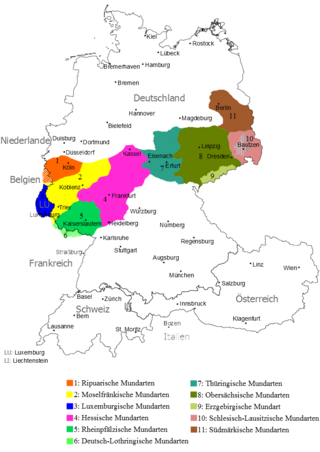| Revision as of 09:40, 4 August 2017 editOoswesthoesbes (talk | contribs)403 edits →References← Previous edit | Revision as of 07:05, 17 October 2017 edit undoSarcelles (talk | contribs)Autopatrolled, Extended confirmed users, Pending changes reviewers9,112 editsm Colognian (Kölsch) doesn't belong in info boxNext edit → | ||
| Line 20: | Line 20: | ||
| | iso3 = none | | iso3 = none | ||
| | lc1 = ksh | | lc1 = ksh | ||
| | ld1 = |
| ld1 = Ripuarian | ||
| | glotto = ripu1236 | | glotto = ripu1236 | ||
| | glottorefname = Ripuarian | | glottorefname = Ripuarian | ||
Revision as of 07:05, 17 October 2017
For other uses, see Ripuarian (disambiguation).| This article does not cite any sources. Please help improve this article by adding citations to reliable sources. Unsourced material may be challenged and removed. Find sources: "Ripuarian language" – news · newspapers · books · scholar · JSTOR (September 2012) (Learn how and when to remove this message) |
| Ripuarian | |
|---|---|
| Ripoarisch | |
| Native to | Germany, Belgium, Netherlands |
| Region | North Rhine-Westphalia, Rhineland-Palatinate, Liège, Limburg |
| Native speakers | ≈ 900,000 |
| Language family | Indo-European |
| Language codes | |
| ISO 639-3 | None (mis)Individual code: ksh – Ripuarian |
| Glottolog | ripu1236 |
 Area where Ripuarian is spoken. Green = sparsely populated forest. Area where Ripuarian is spoken. Green = sparsely populated forest. | |
 Central German language area. 1 = Ripuarian. Central German language area. 1 = Ripuarian. | |
Ripuarian (also Ripuarian Franconian or Ripuarisch Platt; natively Ripoarėsch) is a German dialect group, part of the West Central German language group. Together with the Moselle Franconian which includes the Luxembourgish language, Ripuarian belongs to the larger Central Franconian dialect family and also to the Rhinelandic linguistic continuum with the Low Franconian languages.
It is spoken in the Rhineland, south of the Benrath line, from northwest of Düsseldorf and Cologne, to Aachen in the west, and Waldbröl in the east. The language area also comprises the north of the German-speaking Community of Belgium as well as the southern edge of the Limburg province of the Netherlands, especially Kerkrade (Kirchroa). The name derives from the Ripuarian Franks (Rheinfranken), who settled in the area from the 4th century onward.
The most famous member is Kölsch, the local dialect of Cologne. Dialects belonging to the Ripuarian group almost always call themselves Platt like Öcher Platt (of Aachen) or Eischwiele Platt (of Eschweiler), Kirchröadsj Platt (of Kerkrade) Bocheser Platt (of Bocholtz) or Bönnsch Platt (of Bonn). Most of the more than one hundred Ripuarian dialects are bound to one specific village or municipality. Usually there are small distinctive differences between neighbouring dialects (which are, however, easily noticeable to locals), and increasingly bigger differences between the more distant dialects. These are described by a set of isoglosses called the Rhenish fan in linguistics. The way people talk, even if they are not using Ripuarian, often allows them to be traced precisely to a village or city quarter where they learned to speak.
Number of speakers
About a million people speak a variation of Ripuarian dialect, which constitutes about one quarter of the inhabitants of the area. Penetration of Ripuarian in everyday communication varies considerably, as does the percentage of Ripuarian speakers from one place to another. In some places there may only be a few elderly speakers left, while elsewhere Ripuarian usage is common in everyday life. Both in the genuine Ripuarian area and far around it, the number of people passively understanding Ripuarian to some extent exceeds the number of active speakers by far. Estimates assume some ten, and up to twenty million speakers.
Influences
These Ripuarian varieties are related to the Moselle Franconian languages spoken in the southern Rhineland (Rhineland-Palatinate and Saarland) in Germany, to the Luxembourgish language in Luxembourg, to the Low Franconian Limburgish language in the Dutch province of Limburg, and to Low Dietsch in the province of Liège, Belgium. Most of the historic roots of Ripuarian languages are in Middle High German, but there were other influences too, such as Latin, Low German, Dutch, French, and Southern Meuse-Rhenish (Limburgish). Several elements of grammar are unique to Ripuarian, existing in no other German language. Belgium and the Netherlands officially recognise some Ripuarian dialects as minority languages, and the European Union likewise follows.
See also
References
| Languages and dialects of Benelux | |
|---|---|
| Sign languages | |
| Languages of Germany | |||||
|---|---|---|---|---|---|
| Official language | |||||
| Regional/minority languages |
| ||||